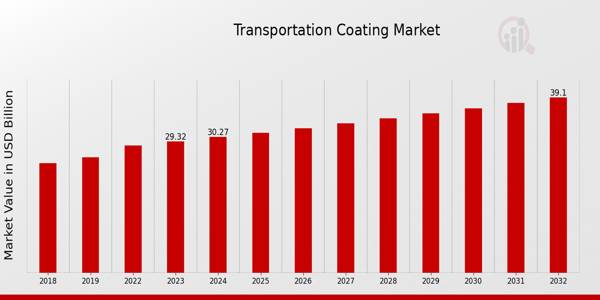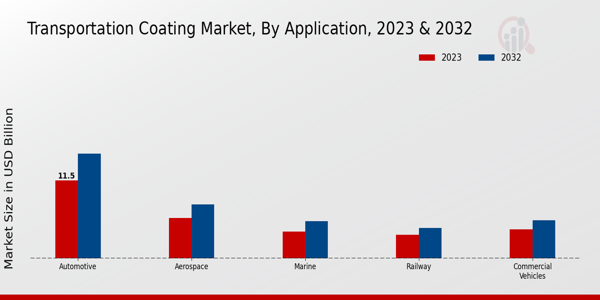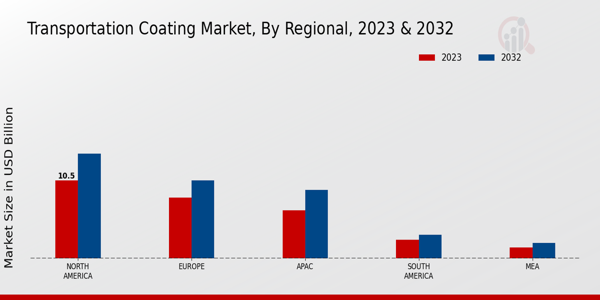Global Transportation Coating Market Overview
The Transportation Coating Market Size was estimated at 31.26 (USD Billion) in 2024. The Transportation Coating Industry is expected to grow from 32.28 (USD Billion) in 2025 to 43.05 (USD Billion) by 2034. The Transportation Coating Market CAGR (growth rate) is expected to be around 3.25% during the forecast period (2025 - 2034).
Key Transportation Coating Market Trends Highlighted
The Transportation Coating Market is influenced by several key market drivers, such as the rising demand for vehicles, increased focus on durability and aesthetics, and ongoing advancements in coating technologies. The growing automotive sector, particularly in emerging economies, is propelling the need for high-quality coatings that enhance vehicle appearance and longevity. Environmental regulations are also driving innovations in eco-friendly coatings, pushing manufacturers to develop sustainable solutions that meet new standards. Additionally, the shift toward electric vehicles is causing a transformation in the types of coatings used, requiring materials that can withstand unique challenges.Opportunities in the market continue to expand as industries seek to enhance their products while adhering to environmental guidelines. The rising emphasis on reducing carbon footprints opens avenues for manufacturers that specialize in eco-friendly transportation coatings. Companies can also explore collaborations with automotive and aerospace industries to develop specialized coatings that cater to specific needs. Growth in logistics and freight transportation further amplifies the potential for coatings that protect against wear and tear, while enhancing vehicle performance. In recent times, trends in the Transportation Coating Market reflect a movement toward innovative technologies, such as nanocoatings and self-healing properties.These innovations not only make defensive features better, but they also offer other advantages, such as improved performance and easier maintenance. Customers may now add a unique touch to their automobiles with the growing popularity of custom paints. Coatings that give protection from ultraviolet light, resistance to corrosion, and thermal stability are also becoming more popular. To keep up with the ever-changing industry and seize new growth opportunities, stakeholders must closely monitor changes in consumer preferences and technical advancements.

Source: Primary Research, Secondary Research, MRFR Database and Analyst Review
Transportation Coating Market Drivers
Increasing Demand for Vehicle Aesthetics and Longevity
The Transportation Coating Market Industry is experiencing a significant surge in demand driven by the rising focus on vehicle aesthetics and enhancing longevity. As consumers become more discerning about vehicle appearance, manufacturers are prioritizing the use of high-quality coatings that not only improve the visual appeal but also provide protective features. These coatings are designed to withstand various environmental factors such as UV rays, rain, and road debris, thereby extending the lifespan of the vehicle's exterior.As transportation technology and design evolve, there is an increasing need for coatings that can offer custom color applications, special effects, and unique finishes. The growing trend of customization in vehicles, particularly among the younger generation looking for personalized options, adds yet another layer of demand for innovative coatings. Additionally, regulatory standards regarding emissions and waste management are prompting manufacturers to develop and adopt eco-friendly coating solutions.The interplay of aesthetic considerations, durability requirements, and regulatory compliance fosters a robust market for transportation coatings, further driving investment and innovation in the Transportation Coating Market Industry.
Technological Advancements in Coating Products
Technological advancements in coating formulations and application processes are significantly influencing the growth of the Transportation Coating Market Industry. Innovations such as nanotechnology, which enhances the durability and stability of coatings, have introduced new choices for both manufacturers and consumers. These advancements lead to the development of coatings that offer superior performance characteristics such as enhanced scratch resistance, easier application, and quicker drying times.Furthermore, advancements in eco-friendly coatings, particularly those with low volatile organic compounds (VOCs) emissions, are in alignment with global environmental standards and consumer preferences for sustainable products. This continuous evolution in technology leads to the introduction of advanced coating solutions that not only meet regulatory requirements but also address customer needs, contributing to the expansion of the Transportation Coating Market.
Growth of the Automotive Sector
The consistent growth of the automotive sector globally acts as a significant driver for the Transportation Coating Market Industry. With an increasing number of vehicle production facilities and rising sales figures, particularly in emerging markets, the demand for transportation coatings is steadily on the rise. The automotive industry's push for enhanced safety features and stylish designs necessitates the use of high-quality coatings aimed at both protection and aesthetics.As vehicle manufacturers inform consumers about technological upgrades and innovative designs, they also highlight the importance of protective coatings which can significantly affect customer satisfaction and vehicle retention.
Transportation Coating Market Segment Insights
Transportation Coating Market Application Insights
The Transportation Coating Market is projected to experience steady growth, with an estimated overall valuation of 29.32 USD Billion in 2023. The application segment within this market plays a crucial role, reflecting the diverse uses of coatings across various industries. The automotive sector, which holds a majority share, is valued at 11.5 USD Billion in 2023 and is expected to grow to 15.45 USD Billion by 2032. This segment's prominence stems from the continuous innovation in vehicle manufacturing, a focus on aesthetics, and durability requirements against harsh environmental conditions.The aerospace application is significant as well, achieving a valuation of 6.0 USD Billion in 2023 and projected to reach 8.0 USD Billion in 2032. This increase is fueled by advancements in technology and the need for lightweight materials that enhance fuel efficiency and performance. The marine application, valued at 4.0 USD Billion in 2023 with growth to 5.5 USD Billion by 2032, is driven by the demand for coatings that provide protection against corrosion and harsh marine environments, making it essential for the longevity of vessels. The railway sector, while smaller, is also an important component of the market with a valuation of 3.5 USD Billion in 2023, expected to grow to 4.5 USD Billion by 2032.This segment values safety and efficiency, highlighting the need for high-performance coatings that ensure the longevity of rail assets. Lastly, commercial vehicles, valued at 4.32 USD Billion in 2023 and growing to 5.65 USD Billion in 2032, contribute significantly to the transportation coating landscape. The increased demand for robust and durable coatings in high-usage vehicles underscores the commercial vehicle segment's importance. Overall, the Transportation Coating Market segmentation paints a picture of a dynamic industry, influenced by technological advancements and the pressing need for strong protective solutions across various modes of transport.The market growth indicates a shift towards sustainability and performance as key drivers in each application area.

Source: Primary Research, Secondary Research, MRFR Database and Analyst Review
Transportation Coating Market Coating Type Insights
The Transportation Coating Market, valued at 29.32 USD Billion in 2023, showcases diverse segments primarily categorized by Coating Type, which play a crucial role in enhancing both functionality and aesthetics in transportation applications. Liquid Coatings are significant for their versatility and ease of application, making them highly preferred across various transportation mediums. Conversely, Powder Coatings dominate the market due to their environmentally friendly attributes and excellent durability, aligning with the increasing demand for sustainable solutions.Thermal Spray Coatings provide vital protection against wear and corrosion, catering particularly to heavy-duty vehicles, while Electrostatic Coatings ensure an even finish, enhancing durability while reducing waste during the coating process. The market growth is driven by trends towards higher durability, reduced environmental impact, and technological advancements. However, challenges such as the required investment for sophisticated equipment may impact small manufacturers. As stakeholders continue to explore innovative technologies, opportunities are emerging to enhance performance and expand market reach within these coating types, ensuring the ongoing evolution of the Transportation Coating Market industry.
Transportation Coating Market Substrate Type Insights
The Transportation Coating Market focuses on a variety of substrate types, significantly influencing its overall performance and application. With a market valuation of 29.32 USD Billion in 2023 and expected growth driving towards 39.1 USD Billion by 2032, there are distinct substrate categories playing a crucial role in market dynamics. Metal substrates dominate this sector, leveraging their strength and durability, particularly in automotive and aerospace applications. Plastic substrates also hold a significant position, often preferred for lightweight applications, which enhances fuel efficiency and design flexibility.Composite substrates, known for their advanced properties, cater to specialized transportation needs, while glass substrates find utility in decorative and functional applications, especially in electronics and displays. The diverse range of substrates highlights the importance of material selection driven by trends like sustainability, technological advances, and regulatory demands, contributing to the Transportation Coating Market revenue. Market trends indicate a growing emphasis on high-performance coatings tailored to these various substrates, revealing substantial opportunities for innovation amidst challenges such as raw material costs and environmental regulations.Understanding the Transportation Coating Market segmentation provides insight into the evolving landscape where each substrate type plays a pivotal role in addressing specific industry needs.
Transportation Coating Market Technology Insights
The Transportation Coating Market, specifically within the Technology segment, is witnessing a notable evolution, with the market valued at 29.32 USD Billion in 2023, projected to grow as trends leaning towards sustainability and eco-friendliness continues to expand. Waterborne Technology has garnered attention due to its lower volatile organic compounds (VOCs), making it a favorable choice for regulatory compliance and environmental standards. This trend signifies its ongoing prominence in various applications, particularly in automotive coatings.Solvent-borne Technology remains significant due to its robust performance and ability to deliver high-quality finishes, dominating sectors that require durability and resistance to weather elements. Meanwhile, UV-cured Technology is gaining traction for its rapid curing capabilities, enhancing production efficiency and reducing energy consumption. The combination of these technologies illustrates a diversification in coating solutions, responding to the growing demands for innovation, efficiency, and environmental responsibility in the Transportation Coating Market industry.Collectively, these dynamics are set to shape future developments as industry players seek competitive advantages through technological advancements and sustainability practices.
Transportation Coating Market Regional Insights
The Transportation Coating Market exhibits diverse dynamics across its regional segments, with North America representing the most substantial market share, valued at 10.5 USD Billion in 2023 and anticipated to grow to 14.1 USD Billion by 2032, driven by a robust automotive sector and stringent regulations on environmental compliance. Europe follows closely, with a valuation of 8.2 USD Billion in 2023, projected to reach 10.5 USD Billion, bolstered by advancements in eco-friendly coatings. The APAC region shows significant potential, starting at 6.5 USD Billion in 2023 and expected to grow to 9.2 USD Billion, as rising infrastructural development and vehicle production fuels demand.South America and MEA have smaller market shares, valued at 2.5 USD Billion and 1.5 USD Billion respectively in 2023, with anticipated growth, highlighting emerging opportunities in these regions, albeit with considerable challenges related to economic fluctuations. The majority holding in North America accentuates its pivotal role in shaping trends within the Transportation Coating Market industry, while APAC's rapid growth indicates a shift towards developing economies in the coatings market. Overall, each region contributes distinctively to the Transportation Coating Market revenue, punctuated by unique challenges and growth drivers specific to their economic landscapes.

Source: Primary Research, Secondary Research, MRFR Database and Analyst Review
Transportation Coating Market Key Players and Competitive Insights
The Transportation Coating Market is characterized by a dynamic competitive landscape where various players strive to enhance their product offerings and expand their market reach. The demand for coatings in the transportation sector is driven by an increasing focus on durability, sustainability, and aesthetic appeal. As transportation manufacturers seek innovative solutions to protect vehicles and components from environmental damage, wear, and corrosion, the competition among key market players intensifies. Companies invest in research and development to create advanced coating technologies that fulfill regulatory requirements and consumer demands for eco-friendly products. This evolving market is underpinned by trends in vehicle electrification, lightweight materials, and improved surface protection, shaping the strategic approaches of major industry participants.Henkel stands out in the Transportation Coating Market due to its extensive product portfolio and strong market presence. The company's core strengths lie in its innovative adhesive and coating solutions that cater to a range of transportation applications, including automotive, aerospace, and rail industries. Henkel's commitment to sustainability is evident in its development of environmentally friendly formulations that align with global environmental regulations and customer preferences. Additionally, the company's robust distribution network enhances its ability to serve diverse markets effectively. Henkel's emphasis on research and development enables it to stay ahead of market trends, offering cutting-edge solutions that meet the evolving needs of its customers while maintaining exceptional performance and quality standards.BASF is another significant player in the Transportation Coating Market, renowned for its diverse range of high-performance coatings tailored for the transportation sector. The company leverages its deep expertise in chemistry and materials science to provide innovative, effective solutions that enhance the functionality and longevity of vehicles. BASF's strong investment in sustainability initiatives results in the formulation of eco-friendly coatings that reduce the environmental impact of automotive production and maintenance. Its extensive research and development capabilities allow BASF to introduce tailored products that improve user experience and meet stringent industry demands. Moreover, the company’s global presence and a well-established supply chain enable it to cater to a wide spectrum of clients, reinforcing its position as a leading provider in the transportation coating market.
Key Companies in the Transportation Coating Market Include
- Henkel
- BASF
- Kansai Paint
- Bayer
- Sika
- RPM International
- Axalta Coating Systems
- Nippon Paint
- Eastman Chemical
- PPG Industries
- AkzoNobel
- Hempel
- 3M
- SherwinWilliams
Transportation Coating Market Industry Developments
The Transportation Coating Market is witnessing significant developments, with companies like Henkel, BASF, and Axalta Coating Systems focusing on innovative product launches to enhance performance and sustainability. Recent trends indicate a strong push towards eco-friendly coatings, driven in part by regulations promoting lower VOC emissions. Companies such as PPG Industries and AkzoNobel are expanding their portfolios to include water-based and high-performance coatings that cater to the increasing demand for lightweight and fuel-efficient vehicle designs. Mergers and acquisitions are also shaping the market, with notable activity reported in the sector; however, specific details on recent transactions involving major players like Sherwin-Williams and RPM International should be examined closely to assess their impact on market dynamics. Furthermore, the valuation growth of firms like Sika and Hempel highlights a robust outlook, indicating increased investment in expanding manufacturing capabilities to meet rising global demand. As companies adapt to evolving technological advancements and consumer preferences, maintaining a competitive edge in product development and sustainability will be vital in this thriving market landscape.
- Transportation Coating Market Segmentation Insights
- Transportation Coating Market Application Outlook
- Automotive
- Aerospace
- Marine
- Railway
- Commercial Vehicles
- Transportation Coating Market Coating Type Outlook
- Liquid Coatings
- Powder Coatings
- Thermal Spray Coatings
- Electrostatic Coatings
- Transportation Coating Market Substrate Type Outlook
- Metal
- Plastic
- Composite
- Glass
- Transportation Coating Market Technology Outlook
- Waterborne Technology
- Solvent-borne Technology
- UV-cured Technology
| Report Attribute/Metric |
Details |
| Market Size 2024 |
31.26 (USD Billion) |
| Market Size 2025 |
32.28 (USD Billion) |
| Market Size 2034 |
43.05 (USD Billion) |
| Compound Annual Growth Rate (CAGR) |
3.25% (2025- 2034) |
| Report Coverage |
Revenue Forecast, Competitive Landscape, Growth Factors, and Trends |
| Base Year |
2024 |
| Market Forecast Period |
2025- 2034 |
| Historical Data |
2020 - 2024 |
| Market Forecast Units |
USD Billion |
| Key Companies Profiled |
Henkel, BASF, Kansai Paint, Bayer, Sika, RPM International, Axalta Coating Systems, Nippon Paint, Eastman Chemical, PPG Industries, AkzoNobel, Hempel, 3M, SherwinWilliams |
| Segments Covered |
Application, Coating Type, Substrate Type, Technology, Regional |
| Key Market Opportunities |
Sustainable coating technologies, Expansion in electric vehicle market, Advanced protective coatings demand, Increase in rail infrastructure investments, Growing Asia-Pacific regional market |
| Key Market Dynamics |
Increasing demand for eco-friendly coatings, Growth in automotive production, Stringent regulatory standards, Advancements in coating technology, Rising consumer awareness on aesthetics |
| Countries Covered |
North America, Europe, APAC, South America, MEA |
Frequently Asked Questions (FAQ) :
The Transportation Coating Market is expected to be valued at 43.05 USD Billion in 2034.
The expected CAGR for the Transportation Coating Market is 3.25% from 2025 to 2034.
North America is expected to dominate the market with a valuation of 14.1 USD Billion by 2032.
The Automotive segment is projected to reach a market size of 15.45 USD Billion by 2032.
Major players include Henkel, BASF, and PPG Industries among others.
The Aerospace segment is expected to be valued at 8.0 USD Billion by 2032.
The Marine segment is forecasted to grow to 5.5 USD Billion by 2032.
The Railway application is expected to be valued at 4.5 USD Billion in 2032.
The Commercial Vehicles segment is anticipated to reach 5.65 USD Billion by 2032.
The APAC region is expected to be valued at 9.2 USD Billion by 2032.

















